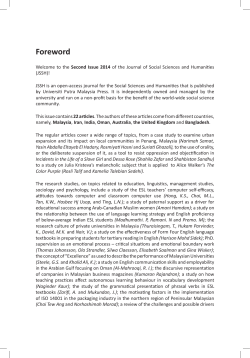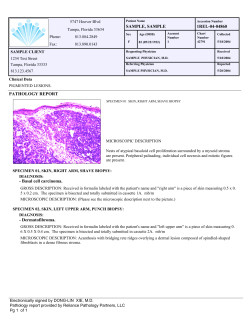
MICROSCOPIC EXAMINATION OF BACTERIA (UNSTAINED & STAINED SMEARS) By
MICROSCOPIC EXAMINATION OF BACTERIA (UNSTAINED & STAINED SMEARS) By Dr. Emad AbdElhameed Morad Lecturer of Medical Microbiology and Immunology There are two principal ways of preparing a microbial specimen for observation with light microscope: 1. Unstained smears (wet preparation): to examine the motility of the bacteria. 2. Stained smears: to study the size, shape, arrangement and staining affinity of the bacteria. 1/11/2017 Dr. Emad AbdElhameed Morad Microscopic examination2 Stained smears • Study size, shape, arrangement and staining affinity of the bacteria. size • Bacteria are measured in microns. 1/11/2017 Dr. Emad AbdElhameed Morad Microscopic examination3 Shap e o Bacteria may have several shapes: Cocci: spherical shape Bacilli: straight rods Vibrios: curved rods Spiral: spiral filaments 1/11/2017 Dr. Emad AbdElhameed Morad Microscopic examination4 Arrange ment Cocci: may occur in clusters (staphylococci), in pairs (pneumococci), in chains (streptococci). Bacilli: may be separately arranged (salmonella), in pairs (klebsiella), in chains (Bacillus anthracis), in Chinese letter arrangement and club shaped ends (Corynebacterium diphtheria). 1/11/2017 Dr. Emad AbdElhameed Morad Microscopic examination5 Cocci arranged in clusters 1/11/2017 Cocci arranged in chains 6 Stains may be: Staining properties 1. Simple stains: using one stain only such as methylene blue, carbol fuchsin. 2. Differential stains: using two stains primary and secondary separated by a step of decolorization. Gram stain 1/11/2017 ZiehlNeelsen stain Dr. Emad AbdElhameed Morad Microscopic examination7 Gram stain With Gram stain, bacteria could be divided into: Gram positive bacteria: bacteria that retain crystal violet iodine dye complex and so appear purple. Gram negative bacteria: bacteria that destain with 95% alcohol and appear pink due to counterstaining with carbol fuchsin. This difference in staining affinity is due to difference in the permeability of cell wall. 1/11/2017 Dr. Emad AbdElhameed Morad Microscopic examination8 Gram staining Preparation and fixation of smears Staining Examination Interpretation 1/11/2017 Dr. Emad AbdElhameed Morad Microscopic examination9 Preparation of smears Put a drop of water on the middle of the slide using the inoculating needle. With the sterile needle, collect bacteria from agar surface by touching the bacterial growth. Rub the tip of the needle on the glass slide in the drop of water in a circular motion till you get homogenous smear. Allow the smear to dry. 1/11/2017 Dr. Emad AbdElhameed Morad Microscopic examination10 Fixation of smears o Pass the slide with the smear side uppermost over the flame for 2-3 times. o Do not overheat the smear. The slide should only be warm when you touch it with hands. o Passage of the smear through heat has two benefits: 1. Fixation of the smear to the slide. 2. Killing of the bacteria in the smear so it becomes non infectious. 1/11/2017 Dr. Emad AbdElhameed Morad Microscopic examination11 Staining of smears o o o o o o o o o Cover the smear with crystal violet for 1 minute. Pour it off then wash with water. Add iodine solution to the smear for 1 minute. Gently wash with water. Decolorize by 95% alcohol and rock the slide from side to side and pour it off. Reapply alcohol till no violet color comes off. Wash with water Counterstain with diluted carbol fuchsin for 1 min. Wash with water. Place the film at angle to air dry or blot dry with filter paper. 1/11/2017 Dr. Emad AbdElhameed Morad Microscopic examination12 Gram staining 1/11/2017 Dr. Emad AbdElhameed Morad Microscopic examination13 Examination of smears o Rack the condenser high and open the iris diaphragm. o Place a drop of immersion oil on the smear. o Put the slide with the smear side up on the stage. o Use the oil immersion lens. o Lower the oil lens till the lens contacts the oil and almost touches the smear. o Look through the eye piece of the microscope. o Focus on the object using the coarse adjustment screw then the fine one. 1/11/2017 Dr. Emad AbdElhameed Morad Microscopic examination14 Interpretation of smears o Comment on the bacterial morphology as regards: Size Staini ng Shap e Arrangeme nt 1/11/2017 Dr. Emad AbdElhameed Morad Microscopic examination15 1/11/2017 Dr. Emad AbdElhameed Morad Microscopic examination16 Ziehl Neelsen stain This stain is used for detection of bacteria which are described as acid fast. These bacteria are not stained with ordinary stains but they need exposure to strong stains with application of heat. Once stained, they will resist decolorization with mineral acids such as H2SO4 or HCL. This property is due to large amount of lipids and fatty acids especially mycolic acid wax in cell wall of these bacteria. 1/11/2017 Dr. Emad AbdElhameed Morad Microscopic examination17 Examples of acid fast bacteria or bacterial structures: A. Tubercle bacilli: retain red carbol fuchsin when decolorized with 20% H2SO4 or 3% HCL in alcohol. B. Lepra bacilli and saprophytic acid fast bacilli: retain red dye when decolorized with 5% H2SO4 or 1% HCL in alcohol. C. Actinomyces clubs and nocardia: retain red dye when decolorized with 0.5% to 1% H2SO4. D. Spores: tolerates only 0.25% to 0.5% H2SO4. 1/11/2017 Dr. Emad AbdElhameed Morad Microscopic examination18 Ziehl Neelsen staining Preparation and fixation of smears Staining Examination Interpretation 1/11/2017 Dr. Emad AbdElhameed Morad Microscopic examination19 Preparation and fixation of smears Tubercle bacilli cause tuberculosis. Pulmonary tuberculosis is the commonest form of tuberculous infection in which tubercle bacilli are found in the sputum of the patients. Smears could be prepared from sputum samples as follows: o Three morning sputum samples are preferable since they represent overnight accumulation. o Choose a purulent portion of sputum and spread it evenly in the middle of a new clean glass slide. o Leave the smear to dry. o Then fix the smear byDr.passing through the flame. Emad AbdElhameed Morad Microscopic examination20 1/11/2017 Staining of smears o Flood the smear with strong carbol fuchsin. Allow the stain to act for 5-10 minutes. o Heat intermittently until the vapor begins to rise. Do not allow the stain to boil or dry. o Pour it off then wash with water. o Flood the smear with 20% H2SO4 or 3% HCL in 95% alcohol. Allow to act for 1 min. then wash with water and reapply fresh acid. Repeat this process several times till the smear becomes colorless or pale pink. o Wash thoroughly with water. o Add methylene blue or malachite green for 2 min. o Wash with water. Dry then examine. 1/11/2017 Dr. Emad AbdElhameed Morad Microscopic examination21 Kinyoun technique o It is called cold Z.N. because no heating is applied. o Penetration of the dye is achieved by increasing concentration of carbol fuchsin and incorporation of a wetting chemical agent. o However, acid fast bacilli stain less well by this method than hot Z.N. 1/11/2017 Dr. Emad AbdElhameed Morad Microscopic examination22 Examination of smears o Put immersion oil on a dry slide. o Examine under oil immersion lens. o Tubercle bacilli appear pink rods that may be single or bundles. o The background appears blue in color. 1/11/2017 Dr. Emad AbdElhameed Morad Microscopic examination23 Positive Z.N. smear for acid fast bacilli (AFB) 1/11/2017 Dr. Emad AbdElhameed Morad Microscopic examination24 Interpretation of smears o One or more bacilli / oil field (+++) o 10 bacilli / slide (++) o 3-9 bacilli / slide (+) o 1-2 bacilli / slide (+/-) 1/11/2017 Dr. Emad AbdElhameed Morad Microscopic examination25 Thank you 1/11/2017 Dr. Emad AbdElhameed Morad Microscopic examination26
© Copyright 2025









